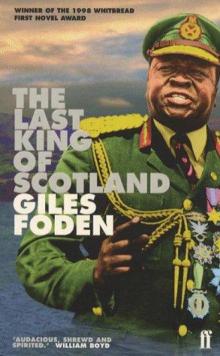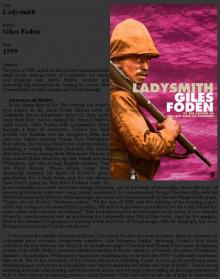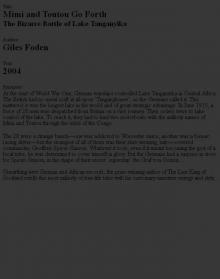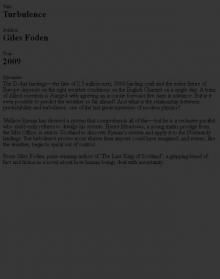- Home
- Giles Foden
2004 - Mimi and Toutou Go Forth Page 19
2004 - Mimi and Toutou Go Forth Read online
Page 19
The fish myth may have some connection to giant Nile perch (Lates angustifrons). Found in Lakes Tanganyika and Victoria and throughout the Nile system, they can grow as large as seven feet long and weigh up to 400 pounds (for comparison, the largest salmon ever caught was probably around 71 pounds and most salmon are 10–16 pounds). As Christopher Ondaatje writes in his Journey to the Source of the Nile (1998): ‘They were known to the ancient Egyptians, and mummified remains of the fish have been found. There is some evidence that Nile perch may have once been the object of cult worship.’
Sadly the men of the Naval Africa Expedition were prevented from fishing for Nile perch by the power of another king. In colonial times, Lake Tanganyika was regarded as the private fishery of the Belgian King Albert I, so Stinghlamber forbade them from using the fishing rods they had brought all that way.
§
By the time Spicer returned to the lake on 12 May 1916, plans were afoot for the Belgians to take Kigoma, the German provincial capital, and the British to take Bismarckburg, their redoubt at the foot of the lake. A British column under one Lieutenant-Colonel Murray was advancing on Bismarckburg through Northern Rhodesia (Zambia). The idea was that Spicer’s flotilla would support them from Lake Tanganyika and prevent the Germans from escaping by water.
Mimi, Toutou, Fifi and Vengeur were loaded up and prepared for the long journey. The men wanted to take the goat from the Kingani, but Spicer wouldn’t let them. With tears in his eyes, Tait led the animal behind a hut and shot it. The goat was burnt and its ashes cast upon the waters of the lake. Eastwood’s chimpanzee Josephine, however, was allowed to join Dr Hanschell on Fifi.
They arrived at Bismarckburg on 5 June to find a white fort armed with cannon and a harbour in which floated a fleet of dhows in the German service.↓
≡ The ruins of the fort can still be seen at Kasanga in present-day Zambia.
Once again, Spicer baulked at attacking. He had no desire to come within range of the fort’s guns. Dudley and Wainwright wanted to rip into the harbour in Mimi and Toutou, guns blazing, and destroy the dhows. Instead, Spicer withdrew the flotilla back to Kituta, a port in Northern Rhodesia. (According to the Official History of the war, Military Operations East Africa, the flotilla did actually fire two shells into the fort before withdrawing. It seems likely this was a Spicer-Simson ploy by which he tried to persuade the Admiralty that he had done the right thing.)
Four days later, when Spicer and his men returned to Bismarckburg, they found a Union Jack flying from the Beau Geste-style fort. The dhows were gone and laughter and jeers greeted the navy men as they landed.
‘Where the hell were you chaps last night?’ called out one of the Rhodesian soldiers in the harbour. ‘You let the Germans get away by sea. We had the fort surrounded!’
Byron Farwell gives a good account of the precise moment when Spicer’s self-confidence took a nosedive. Lieutenant-Colonel Murray was a formidable figure. His colonials, who had sustained casualties while fighting their way through to Bismarckburg, were not the sort to be impressed by ju-ju or ‘successful mystique’. Or by a man in a skirt.
Spicer-Simson ordered Dudley and Hanschell to accompany him as he stepped ashore wearing his gold-braided cap, blue flannel shirt, and his skirt. He asked a young Rhodesian officer to take him to Murray, but he merely pointed to the fort and said, ‘Straight up there. You can’t miss it. Just follow your nose.’ Spicer-Simson’s face flushed, but he said nothing. Marching up to the fort he was greeted with whistles and ribald laughter: ‘Kiss me, Gertie!’ and ‘Oh! la! la!’ and ‘Chase me, Charlie!’
§
Spicer was in with Murray only for a few minutes. No one knows quite what was said, but the glowering Rhodesian was clearly furious. When Spicer stepped outside the room, says Shankland, ‘he was dead white, and looking as if he were not quite sure where he was, and holding out his hands as if he were half blind and must feel his way.’
A few weeks later and Spicer was in trouble again, this time for refusing to let the Belgians use the Allied flotilla to move troops and supplies up and down the lake as part of the final assault on German positions. On 11 June the Belgian seaplanes reported that they had bombed the Graf von Götzen at Kigoma—but nobody knew if she had been put out of action. In his memoirs the ship’s captain Gustav Zimmer writes that the aerial attack ‘did not cause serious damage’, but as Dobold and Bishop point out, ‘the air raids certainly did have some effect on Zimmer and the Germans’ morale’.
The defences of Kigoma were strengthened in expectation of the coming land battle. Spicer’s refusal to offer naval support to the offensive caused ructions between the Belgian and British governments. He told the Admiralty that the Belgians were trying to squeeze the British out of the picture and prevent them acquiring former German territory. The Belgians complained that Spicer was trying to stop them from using their own vessels, not just Mimi and Toutou. Spicer’s relations with his own officers were no better: after falling out with each of them in turn, he resorted to communicating with them only by letter.
These episodes put an end to Spicer’s dreams of glory. When Lieutenant-Colonel Murray’s troops marched out of the Bismarckburg fort on 15 June, the Naval Africa Expedition was ordered to remain behind in its grim, stone-floored rooms. Spicer took to lying on his truckle-bed all day, fully dressed and gazing at the ceiling, refusing to do anything whatsoever. Dudley took command of the flotilla as Spicer sank further and further into lethargy over the next few months. His mood was not helped by the discovery that the fort’s guns—into whose range he had not wanted to bring Mimi and Toutou—were, in fact, wooden dummies.
In the first weeks of July, the Belgian General Tombeur’s Brigade Nord began their attack on Kigoma, which they captured on 28 July. An ignominious end was in store for the Graf von Götzen as well. Two days earlier, a desperate Zimmer had given orders for her to be scuttled. The supership was filled with cement to make her sink, but Zimmer hadn’t given up hope completely. He ordered the three shipwrights from Papenburg to grease the Götzen’s engines to preserve them and allow her to be sailed if she were ever raised. Then he sank her at the mouth of the Malagarasi River (one of the biggest rivers in Tanzania), so that she wouldn’t be too deep to bring back to the surface.
The Times of 2 August 1916 reported: ‘During the same period our Tanganyikan fleet showed great activity. The defences of the port of Ujiji [Kigoma] and enemy vessels in the harbour were subjected to almost daily bombing. The German gunboat Graf von Götzen is reported destroyed. We have secured complete liberty of action on Lake Tanganyika.’ The following day’s report gave more detail, though it does not mention the crucial fact that the ship was actually scuttled. ‘While steaming along the German shores of the lake the Belgian gunboat Netta commanded by Lieutenant Lenaerts surprised at 6 AM on July 28 the Graf von Götzen as she was disembarking troops. The Belgian boat immediately opened fire, whereupon the German boat attempted to escape, but was sunk in 15 minutes.’
What actually happened was that when the Belgians took the river mouth, they noticed the Götzen’s masts sticking out of the water and sent down divers to investigate her condition. It turned out that her big guns—the very ones that had been brought off the Königsberg the previous year—had been replaced with wooden decoys, like the guns in the fort at Bismarckburg. Needing them for his beleaguered land forces, the German commander von Lettow had ordered Zimmer to hand them over to him in mid-May—about the time Spicer came back from the coast. So the Commander—who was still lying in torpor at Bismarckburg when this news came through—could have taken the defenceless Götzen with Mimi and Toutou after all.
TWENTY-TWO
Following Spicer’s bad example, the men were also becoming demoralised. On 23 August 1916 Dr Hansch-ell took the difficult decision to invalid out Spicer. He could go home. According to Shankland, ‘Spicer came to life at once’!
There was no great leave-taking, neither for the men of the Naval Africa Expedition nor
for Mimi and Toutou. Nor even for the Holo-holo. One day Spicer was there, the next he was gone.
To his African devotees he briefly became something like le dieu cache, the ‘Hidden God’ of the Christian West of whom the White Fathers sometimes spoke. What was once plainly manifested—by semaphore, by blood on the decks of ships, by the image of the snake—would soon recede into myth, since they looked for him and found him not.
Only the statues remained, but they too would eventually be drained of their occult power, becoming mere curiosities in a museum. The Holo-holo fetish was a means of evading the god’s displeasure. You embody the god to appease him. If he is not there, if he is strolling down the Mall, for instance, there is no need.
Worthy fame and great renown were uppermost in Spicer’s mind and he was soon up to his old tricks again. Although the medical certificate Dr Hanschell had given him cited ‘acute mental debility’, in his own report to the Admiralty Spicer stated that he had malaria, dysentery and various other diseases. These seemed to have cleared up nicely by the time he reached London in September 1916.
He got a mixed reception. The Navy gave him his DSO (Distinguished Service Order), but also reprimanded him for not accommodating the Belgians more gracefully. For their part, the Belgians awarded him their Commander of the Order of the Crown, as well as the Croix de Guerre—perhaps recognising that officers in the tropics operate under a great deal of stress (Spicer’s old adversary Stinghlamber had also been invalided out).
During 1917 Spicer claimed prize money↓ for sinking the Kingani and his story ran as a feature in many newspapers.
≡ An antiquated Royal Navy procedure whereby commanding officers receive a cash bonus for capturing an enemy vessel intact.
He was ‘The Hero of the Gunboats’ whose ‘Nelson Touch on the African Lake’ had rightly earned him his medals. He had persuaded the newspapers of his heroism, but the Navy never let him have a command again. ‘His tactless behaviour might have contributed to a serious disaster,’ grumbled Admiral Gamble, who was charged with investigating the incident. Spicer was given the same desk job he had had before the adventure began, dealing with the transfer of Merchant Marine Officers to the Royal Navy.
Characters fly off in many directions from a battle-field. Some of the Naval Expedition’s members stayed in Africa; others couldn’t wait to return to Britain. They came back by a different route, paddling long dug-out canoes down the Luapula River, which descends gently down into what is now Zambia. (Mimi and Toutou were handed over to the army for use as transports.) The Germans weren’t so lucky. Rosenthal, the officer who had swum to Lukuga, did not get home until 1920.
After Kigoma was captured, the three shipwrights, Ruter, Wendt and Tellmann, were sent to a prisoner-of-war camp in Egypt. They escaped by tunnelling with some other men and making for the Nile. As Wilhelm Tellmann’s son recalled: ‘They swam across the Nile, but the one who was carrying the food drowned. A few days later they were caught again and brought back to the same camp.’ The shipwrights eventually returned to Papenburg in 1919, deeply disappointed. ‘I went away to become rich,’ complained Wendt, ‘and came back a poor man—and a sick man too.’
Dr Hanschell also had a terrible time of it. Wounded in the forearm by shrapnel in one of the last actions of the lake war—which took place soon after Spicer left—he developed sepsis and a malignant form of malaria. Like Spicer before him, though with good reason, he took to his bed for several weeks.
Disease wasn’t the only thing to beset the doctor. The symbols of Spicer’s dominance over the Holo-holo plagued him, too, as if the Commander were exerting his power from afar. One day, writes Shankland, Dr Hanschell awoke from sleep in his stone-and-cement cell in the Bismarckburg fort ‘to see a three-foot long mother snake gliding across the floor in company with six child snakes each one foot long. He staggered from his bed, seized his stick, and killed three of the children: the mother and the rest of the family got away.’
The doctor’s condition worsened and he was evacuated to Northern Rhodesia, after being taken down the lake in Mimi. On landing he was carried 14 miles in a canvas hammock through a heavy rainstorm by his servant Rupia and a team of African carriers. At one point the hammock split and the bearers abandoned the doctor and Rupia in the middle of the thunder and the lightning. Some 50 years later, Dr Hanschell told Shankland that lying there in the bush he felt that ‘he had reached the end, and he wished he could have told Eastwood about the Devil’s Advocate’s spectacular exit from this world in blinding flashes of lightning and a strong smell of sulphur. Then he saw Rupia lying beside him, trying to keep him warm, and trying to shield him from the rain with the torn canvas.’
The doctor eventually got back to England in June 1917. He met Eastwood, who told him everyone had come home safely,↓ then he went to see Spicer.
≡ We had not a single casualty of any sort,’ said Spicer in his lecture, ‘unless we must count a Sub-Lieutenant who, being threatened by a German native, hit him with his fist, and, his finger catching on the native’s teeth, it had to be amputated because septic complications set in.’ It is not clear whose finger this was. If it was Mollison (who was promoted to Sub-Lieutenant during the expedition), then he and Tait would have truly become twins, given that his fellow Scot set out from London with only nine digits.
He found Spicer in the same meagre office where he had interviewed him at the start of the expedition, sitting under a dusty portrait of the King. Even the Major of Marines who had tapped his temple to indicate Spicer’s insanity was still sitting there.
Spicer was cordial, but not especially friendly. Looking down, Dr Hanschell noticed that Spicer was still wearing the ring he had taken from the dead captain of the Kingani. After exchanging pleasantries, they agreed that they and their wives would meet soon, but they never did. After he left, wandering down the Mall past the statue of Captain Cook, the doctor was as mystified by Spicer as ever.
§
War continued to rage in Africa until late 1918. Von Lettow’s forces (reduced to 2,000 men) led the British a merry dance all over East and Central Africa. Field Marshal Smuts, the former Boer leader now in charge of Allied forces in sub-Saharan Africa, developed a great deal of respect for the Germans, whose officers survived by hunting big game. In the course of his adventures, von Lettow also learned how to carve wooden statues like those of the African tribes who followed him.
On 13 November 1918 a British dispatch rider carrying a white flag caught up with von Lettow and told him the war was over. Germany had surrendered. Von Lettow’s endurance and brilliant application of military tactics had made him an instant hero on his return home. When Adolf Hitler came to power, he offered von Lettow the post of Ambassador to Britain, but the old soldier refused. He hated the Nazis and all they stood for.
Von Lettow fell on hard times after the Second World War. In 1951, according to Judith Listowel in The Making of Tanganyika, ‘Field Marshal Smuts discovered him in Hamburg, living in poverty from the proceeds of his wood-carvings.’ In 1953 Smuts arranged for von Lettow to visit Tanganyika—then a British mandate territory—where he was given an honour parade by his former African troops, as well as British officers of the King’s African Rifles. Unlike Spicer, whose heroism was to some extent a pose, von Lettow was the real thing, and the Africans and British knew it.
But as Listowel observes: ‘As the applause died away into the African night, it probably did not occur to either the English officers or to the German general that they belonged to a passing age. To an age in which men were proud to have waged a gentleman’s war.’
This is, perhaps, where Spicer erred. His conduct was not that of a true gentleman, which is probably why he has been forgotten.↓
≡ Not entirely. A Spicer-Simson tin-soldier model, complete with skirt, has been available for some years to devotees of colonial war games. This would have amused Dr Hanschell no end. Hanschell himself became director of the Venereal Diseases Clinic of the Seamen’s Hospital in L
ondon’s Royal Albert Dock after the War, retiring in 1950. In 1931 he published an article in the Lancet on the efficacious use of acriflavine for treatment of 2,500 men with gonorrhoea, giving each of them a daily dose for five months. He died in 1968, the year Shankland’s book was published.
Yet so has the theatre in which he fought for pre-eminence. Even today, the East African campaign is regarded as a relatively unimportant part of the First World War. Extensive histories of the conflict did not emerge until many years after it ended, in such books as Byron Farwell’s The Great War in Africa and Ross Anderson’s The Forgotten Front. The most significant intervention has been Hew Strachan’s The First World War. A Call to Arms (2001), the first book to put the East African campaign in its full context. He describes Spicer as ‘one of the Royal Navy’s less distinguished officers’. But the story of the Naval Africa Expedition has had a life outside the history books. In The Forgotten Front, Anderson notes in passing how ‘Humphrey Bogart’s famous film, The African Queen, inspired by an episode of the campaign, often provides its only lasting image’.
That episode was, in fact, this very story.
TWENTY-THREE
‘There is an elation in victory, even when wounded men have to be borne very carefully along the jetty to the hospital tent; even when a telegraphic report has to be composed and sent to the Lords Commissioners of the Admiralty; even when a lieutenant-commander of no linguistic ability has to put together another report in French for the Belgian governor. He could at least congratulate himself on having won a naval victory as decisive as the Falklands or Tsu-Shima, and he could look forward to receiving the DSO and the Belgian Order of the Crown and a step in promotion which would help to make him an Admiral some day.’
He never made it to Admiral, but in some ways Spicer-Simson accrued the glory he craved. He lived to see part of his story immortalised in a fine novel, The African Queen (1935) by C. S. Forester (of Horatio Hornblower fame), from which the passage above is taken. We do not know if Spicer ever read it, but if he did, he no doubt bridled at not playing the lead role. What Forester did with the facts—and what the film director John Huston did with Forester’s novel 20-odd years later—offers us a fascinating case-study of what happens when history, fiction and film collide.

 The Last King of Scotland (1998)
The Last King of Scotland (1998) Zanzibar
Zanzibar Turbulence
Turbulence The Last King of Scotland
The Last King of Scotland 1999 - Ladysmith
1999 - Ladysmith 2004 - Mimi and Toutou Go Forth
2004 - Mimi and Toutou Go Forth 2009 - Turbulence
2009 - Turbulence